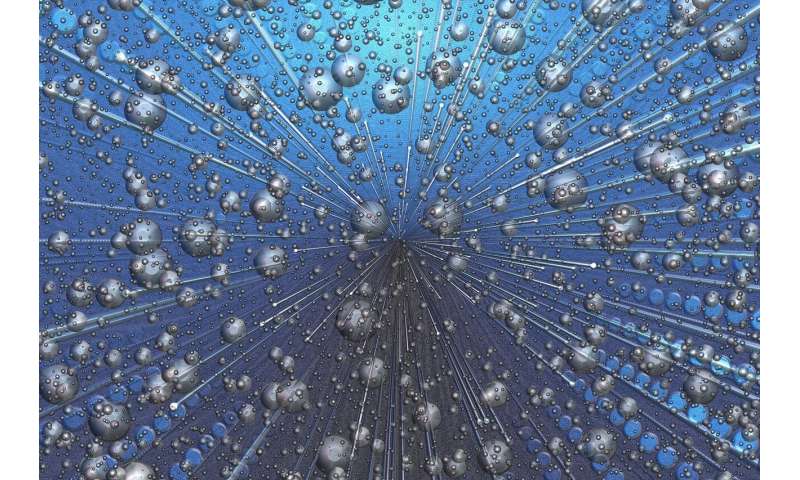Quantum simulators for gauge theories
by Science X staff
To simulate in a laboratory what happens in particle accelerators has been an ambitious goal in the study of the fundamental forces of nature pursued by high-energy physicists for many years. Now, thanks to research conducted by the groups of statistical physics of SISSA—Scuola Internazionale Superiore di Studi Avanzati and the "Abdus Salam" International Centre for Theoretical Physics (ICTP), that goal is closer to reach.
"We have dealt with a gauge theory, more precisely the Schwinger model, which mathematically describes the interaction between microscopic charged particles, like electrons and positrons, and an electric field in a spatial dimension," said Federica Surace, Ph.D. student at SISSA and lead author of the research, recently published on Physical Review X. "We have shown that this theory can be simulated in an experiment with ultracold atoms better than what calculators have done to date. This experiment was conducted in Prof. Lukin's laboratory at Harvard University."
Investigating the fundamental forces of nature
The study, to which Ph.D. students Paolo P. Mazza, Giuliano Giudici, Alessio Lerose, and their supervisors Andrea Gambassi of SISSA and Marcello Dalmonte of ICTP also contributed, shows that the experiment carried out overseas can be interpreted as a "quantum simulator" of a gauge theory, an important connection because it confirms the potential of the latter to investigate the mysteries associated with the fundamental forces of nature.
"The theories which describe the fundamental interactions, known as gauge theories, are behind our current understanding of the physics of the universe, and to understand their dynamics is one of the most important unanswered questions in theoretical physics," adds Alessio Lerose, co-author of the publication. "To infer from this the behaviour of matter in extreme conditions, as in high energy collisions between heavy atomic nuclei, inside the stars and the primordial universe post Big-Bang, is a very complex challenge which has severely tested the theoretical and computational methods available to physicists."
The gauge theories allow, for example, to understand what happens in experiments like those conducted at CERN in Geneva. "These phenomena are very complex" Federica Surace adds. "Due to their quantum nature, it is very difficult to make reliable predictions, even with the most modern and powerful computers."
Quantum Simulators
One of the methods devised to carry out this type of investigation is precisely that of quantum simulators, made up of components, typically atoms cooled at temperatures close to absolute zero which are controlled by laser and magnetic fields, whose behaviour is governed by mathematical equations similar to those of the systems which scientists want to study, but which are much easier to create.
"These tools," continues Surace, "allow to investigate the gauge theories using experimental equipment as large as a room instead of an accelerator which is tens of kilometres long. The research in this field is just beginning and this goal is still a long way off and yet the first results are encouraging".
This is demonstrated by the work of the physicists of SISSA and of ICTP, and it has already provided important proof of the potential of quantum simulators already available in the laboratory to study the theories behind our understanding of the Universe.
"We have demonstrated that the model implemented by the quantum simulator created in Harvard is none other than one of the simplest gauge theories but which, in any case, foresees highly non-trivial phenomena, such as vacuum decay and the confinement of elementary particles," explains Alessio Lerose, underlining the importance of this result to create a simulator that can be used for all quantum systems. "At present, there is no "universal simulator", namely a quantum device which can be programmed to simulate any other quantum system, but creating one is a key objectives of the research in this area of physics. Quantum simulators now exist that possess an excellent level of control that allows for simulation of less complex systems. In reality, we now know that with some further effort it is also possible to simulate more complex quantum theories, such as the Schwinger model which has been the protagonist of our study".
More information: Federica M. Surace et al, Lattice Gauge Theories and String Dynamics in Rydberg Atom Quantum Simulators, Physical Review X (2020). DOI: 10.1103/PhysRevX.10.021041
Journal information: Physical Review X
Provided by International School of Advanced Studies (SISSA)